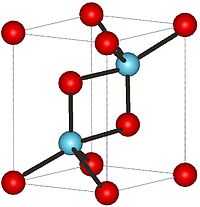Neodymium(III) oxide
| Neodymium(III) oxide | ||
|---|---|---|
 | ||
 | ||
| IUPAC name Neodymium(III) oxide | ||
| Other names Neodymium oxide, Neodymium sesquioxide | ||
| Identifiers | ||
| CAS number | 1313-97-9 | |
| Properties | ||
| Molecular formula | Nd2O3 | |
| Molar mass | 336.48 g/mol | |
| Appearance | light bluish gray hexagonal crystals | |
| Density | 7.24 g/cm3 | |
| Melting point | 2233 °C | |
| Boiling point | 3760 °C[1] | |
| Solubility in water | .0003 g/100 mL (75°C) | |
| Structure | ||
| Crystal structure | Hexagonal, hP5 | |
| Space group | P-3m1, No. 164 | |
| Thermochemistry | ||
| Std enthalpy of formation ΔfH |
-1807.9 kJ·mol-1 | |
| Standard molar entropy S |
158.6 J·mol-1·K-1 | |
| Specific heat capacity, C | 111.3 J·mol-1·K-1[1] | |
| Related compounds | ||
| Other anions | Neodymium(II) chloride Neodymium(III) chloride | |
| Other cations | Uranium(VI) oxide Praseodymium(III) oxide Promethium(III) oxide | |
| Except where noted otherwise, data are given for materials in their standard state (at 25 °C (77 °F), 100 kPa) | ||
| Infobox references | ||
Neodymium(III) oxide or neodymium sesquioxide is the chemical compound composed of neodymium and oxygen with the formula Nd2O3. It forms very light grayish-blue hexagonal crystals.[1] The rare earth mixture didymium, previously believed to be an element, partially consists of neodymium(III) oxide.[2]
Uses
Neodymium(III) oxide is used to dope glass, including sunglasses, to make solid-state lasers, and to color glasses and enamels.[3] Neodymium-doped glass turns purple due to the absorbance of yellow and green light, and is used in welding goggles.[4] Some neodymium-doped glass is dichroic; that is, it changes color depending on the lighting. One kind of glass named for the mineral alexandrite appears blue in sunlight and red in artificial light.[5] About 7000 tonnes of neodymium(III) oxide are produced worldwide each year. Neodymium(III) oxide is also used as a polymerization catalyst.[4]
Reactions
Neodymium(III) oxide is formed when neodymium(III) nitride or neodymium(III) hydroxide is burned in air.[6]
References
- ↑ 1.0 1.1 1.2 Lide, David R. (1998), Handbook of Chemistry and Physics (87 ed.), Boca Raton, FL: CRC Press, pp. 471; 552, ISBN 0-8493-0594-2
- ↑ Brady, George Stuart; Clauser, Henry R.; Vaccari, John A. (2002), Materials Handbook (15 ed.), New York: McGraw-Hill Professional, p. 779, ISBN 978-0-07-136076-0, retrieved 2009-03-18
- ↑ Eagleson, Mary (1994), Concise Encyclopedia of Chemistry, Springer, p. 680, ISBN 978-3-11-011451-5, retrieved 2009-03-18
- ↑ 4.0 4.1 Emsley, John (2003), Nature's Building Blocks, Oxford University Press, pp. 268–9, ISBN 978-0-19-850340-8, retrieved 2009-03-18
- ↑ Bray, Charles (2001), Dictionary of Glass (2 ed.), University of Pennsylvania Press, p. 103, ISBN 978-0-8122-3619-4, retrieved 2009-03-18
- ↑ Spencer, James Frederick (1919), The Metals of the Rare Earths, London: Longmans, Green, and Co, p. 115, retrieved 2009-03-18